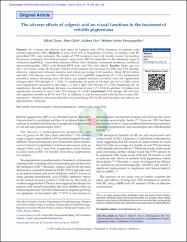| dc.contributor.author | Totan, Yüksel | |
| dc.contributor.author | Güler, Emre | |
| dc.contributor.author | Yüce, Aslıhan | |
| dc.contributor.author | Dervişoğulları, Mehmet Serdar | |
| dc.date.accessioned | 10.07.201910:49:13 | |
| dc.date.accessioned | 2019-07-10T19:56:23Z | |
| dc.date.available | 10.07.201910:49:13 | |
| dc.date.available | 2019-07-10T19:56:23Z | |
| dc.date.issued | 2017 | en_US |
| dc.identifier.citation | Totan, Y., Güler, E., Yüce, A. ve Dervişoğulları, M. S. (2017). The adverse effects of valproic acid on visual functions in the treatment of retinitis pigmentosa. Indian Journal of Ophthalmology, 65(10), 984-988. https://dx.doi.org/10.4103/ijo.IJO_978_16 | en_US |
| dc.identifier.issn | 0301-4738 | |
| dc.identifier.issn | 1998-3689 | |
| dc.identifier.uri | https://dx.doi.org/10.4103/ijo.IJO_978_16 | |
| dc.identifier.uri | https://hdl.handle.net/20.500.12511/2689 | |
| dc.description | WOS: 000413741300015 | en_US |
| dc.description | PubMed ID: 29044065 | en_US |
| dc.description.abstract | Purpose: To evaluate the efficacy and safety of valproic acid (VPA) treatment in patients with retinitis pigmentosa (RP). Methods: A total of 48 eyes of 24 patients (13 males, 11 females) with RP prescribed VPA were included. The length of VPA treatment was 6-12 months (mean 9.4 months). Parameters evaluated were best-corrected visual acuity (BCVA) (logarithm of the minimum angle of resolution [logMAR]), visual field analyses (VFAs) with Humprey automated perimetry, multifocal electroretinography (ERG) with Roland-RETI scan, and VPA side effects. Results: Mean age was 34.3 +/- 10.3 years (range 18-56 years). Fifteen of the patients (30 eyes) had two ERG and VFA tracings, allowing comparison between baseline and follow-up (range 6-12 months). Mean BCVA before and after VPA therapy was 0.36 +/- 0.38 and 0.36 +/- 0.37 logMAR, respectively (P = 0.32). Quantitative perimetric indices including mean deviation and pattern standard deviation were not significantly changed after VPA therapy (P > 0.05). P1 amplitudes (in terms of nV/deg(2) and mV) of ERG waves were significantly decreased in the rings 1, 3, and 4 after VPA therapy (P < 0.05). Regarding the N1 amplitudes, the only significant decrease was observed in area 1 (P = 0.03). In addition, N1 latency was significantly increased in area 3 after VPA therapy (P = 0.04). Conclusions: VPA therapy did not have any significant benefit on BCVA and VFA. In addition, it may be associated with decline in some ERG parameters. Therefore, physicians should avoid prescribing VPA for RP until its safety and efficacy are appropriately evaluated. | en_US |
| dc.language.iso | eng | en_US |
| dc.publisher | Medknow Publications & Media Pvt Ltd | en_US |
| dc.rights | info:eu-repo/semantics/openAccess | en_US |
| dc.rights | Attribution-NonCommercial-ShareAlike 3.0 Unported | * |
| dc.rights.uri | https://creativecommons.org/licenses/by-nc-sa/3.0/ | * |
| dc.subject | Electroretinogram | en_US |
| dc.subject | Retinitis Pigmentosa | en_US |
| dc.subject | Valproic Acid | en_US |
| dc.subject | Visual Field | en_US |
| dc.title | The adverse effects of valproic acid on visual functions in the treatment of retinitis pigmentosa | en_US |
| dc.type | article | en_US |
| dc.relation.ispartof | Indian Journal of Ophthalmology | en_US |
| dc.department | İstanbul Medipol Üniversitesi, Tıp Fakültesi, Cerrahi Tıp Bilimleri Bölümü, Göz Hastalıkları Ana Bilim Dalı | en_US |
| dc.identifier.volume | 65 | en_US |
| dc.identifier.issue | 10 | en_US |
| dc.identifier.startpage | 984 | en_US |
| dc.identifier.endpage | 988 | en_US |
| dc.relation.publicationcategory | Makale - Uluslararası Hakemli Dergi - Kurum Öğretim Elemanı | en_US |
| dc.identifier.doi | 10.4103/ijo.IJO_978_16 | en_US |
| dc.identifier.wosquality | Q4 | en_US |
| dc.identifier.scopusquality | Q3 | en_US |



















